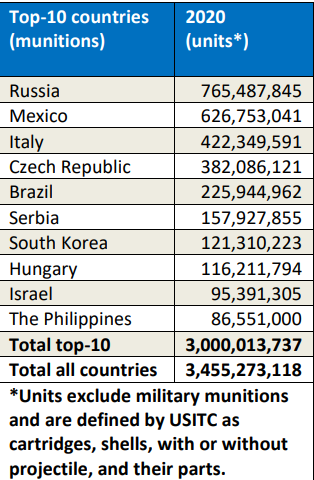More info.
There have been a lot of numbers thrown around with regards to the Russian ammo ban. Many of them are, as near as I can tell, wrong.

www.thefirearmblog.com
In
a fact sheet published by the SAAF, they estimate that 765,487,845 shells, cartridges, or parts thereof, came in from Russia in 2020. Going off their estimate of about 11.8 billion rounds manufactured or imported in 2018, Russian ammo accounts for roughly 6.5% of all ammunition on the domestic market.
Small Arms Analytics & Forecasting 2020 Numbers
Not an insignificant percentage by any means, but certainly less than the 40% estimates I’ve seen floating around. The percentage that Russian ammo imports make up of certain calibers, such as 7.62×39, 5.45×39, 9×18, or 7.62x54R, is almost certainly much higher, and may very well be 40%.
Note:
HOW DO AMMO IMPORTS WORK?
First things first, we have to establish how importers actually get imports. The ATF has of course, not made this easy. Fortunately, I was able to talk briefly with a pair of experts and get the layman’s version. I would like to thank David of Discreet Ballistics, and Christopher Thomas of Mark Barnes & Associates for answering my questions. David is a Type 08 FFL holder. Type 08 FFLs are those that actually permit you to go about importing firearms and ammunition from abroad. Christopher Thomas is an attorney who specializes in the import of firearms and ammunition.
For a Type 08 FFL, the process is fairly straightforward. Once you have your FFL, you register as an importer with the ATF and Department of State. Then the FFL sources whatever it is they would like to import and fills out an ATF Form 6. A Form 6 is good for two years but is limited to the types and quantities of whatever is on the form. For example, let’s say Generic Ammo Importer fills out a Form 6 to import a bunch of ammo from Russia. They would write on the form they are importing 20 million rounds of 7.62×39 FMJ Tulammo, or whatever else they are importing. They may also import some sporting shotguns, some 9mm, or what have you. The point is that it all goes on a Form 6.
Now comes the actual importation process. Twenty million rounds of ammo is a lot. So Generic Ammo Importer might bring it over in 10 shipments of 2 million rounds. For each shipment, you have to file a Form 6A. This is different from a standard Form 6. While a Form 6 requires ATF approval, just like a Form 1 to build your own suppressor, a 6A does not. The importer files it with customs, but it does not require any sort of approval process.
WHY DOES A FORM 6 VS A 6A MATTER?
This is where the wording of the new ban comes into play. The exact text of the order reads:
Since 6As theoretically do not require approval, anyone with an existing Form 6 should still be able to bring in whatever ammo they are already approved for. The number of still valid Form 6s is likely in the dozens, if not hundreds, so ammo will still trickle in over the next two years.
The headline of an ATF Form 6



